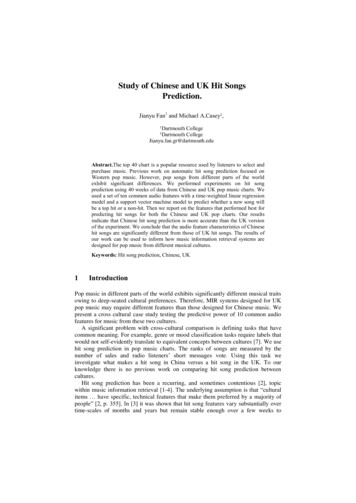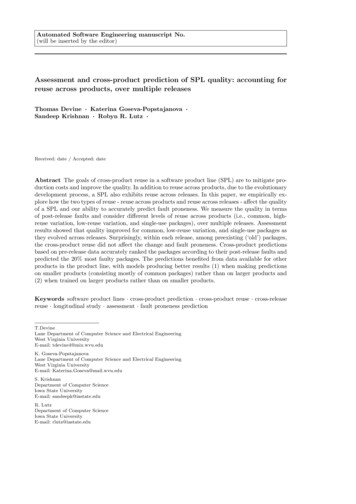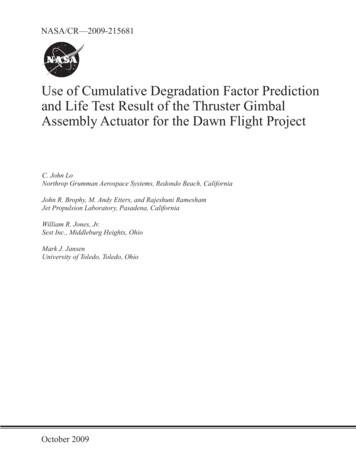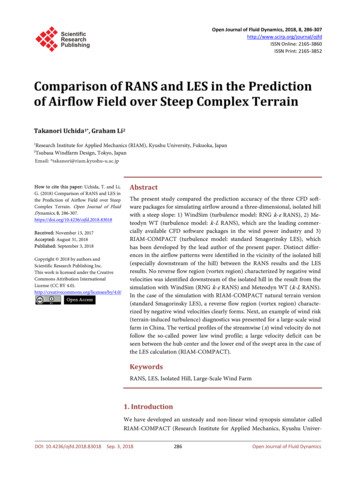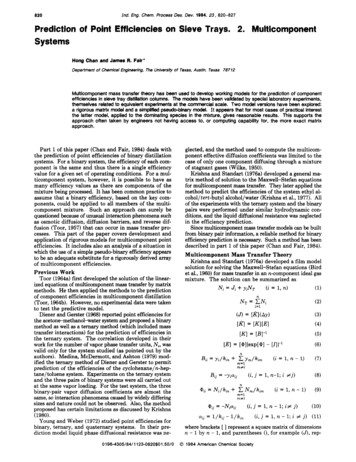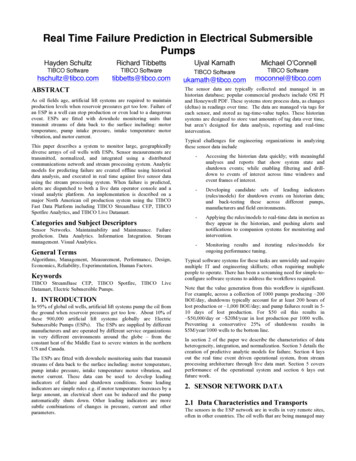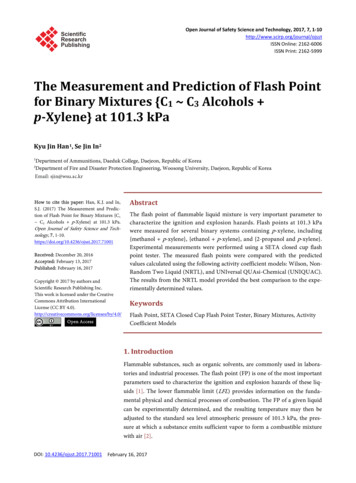
Transcription
Open Journal of Safety Science and Technology, 2017, 7, 1-10http://www.scirp.org/journal/ojsstISSN Online: 2162-6006ISSN Print: 2162-5999The Measurement and Prediction of Flash Pointfor Binary Mixtures {C1 C3 Alcohols p-Xylene} at 101.3 kPaKyu Jin Han1, Se Jin In2Department of Ammunitions, Daeduk College, Daejeon, Republic of KoreaDepartment of Fire and Disaster Protection Engineering, Woosong University, Daejeon, Republic of Korea12How to cite this paper: Han, K.J. and In,S.J. (2017) The Measurement and Prediction of Flash Point for Binary Mixtures {C1 C3 Alcohols p-Xylene} at 101.3 kPa.Open Journal of Safety Science and Technology, 7, ved: December 20, 2016Accepted: February 13, 2017Published: February 16, 2017Copyright 2017 by authors andScientific Research Publishing Inc.This work is licensed under the CreativeCommons Attribution InternationalLicense (CC BY en AccessAbstractThe flash point of flammable liquid mixture is very important parameter tocharacterize the ignition and explosion hazards. Flash points at 101.3 kPawere measured for several binary systems containing p-xylene, including{methanol p-xylene}, {ethanol p-xylene}, and {2-propanol and p-xylene}.Experimental measurements were performed using a SETA closed cup flashpoint tester. The measured flash points were compared with the predictedvalues calculated using the following activity coefficient models: Wilson, NonRandom Two Liquid (NRTL), and UNIversal QUAsi-Chemical (UNIQUAC).The results from the NRTL model provided the best comparison to the experimentally determined values.KeywordsFlash Point, SETA Closed Cup Flash Point Tester, Binary Mixtures, ActivityCoefficient Models1. IntroductionFlammable substances, such as organic solvents, are commonly used in laboratories and industrial processes. The flash point (FP) is one of the most importantparameters used to characterize the ignition and explosion hazards of these liquids [1]. The lower flammable limit (LFL) provides information on the fundamental physical and chemical processes of combustion. The FP of a given liquidcan be experimentally determined, and the resulting temperature may then beadjusted to the standard sea level atmospheric pressure of 101.3 kPa, the pressure at which a substance emits sufficient vapor to form a combustible mixturewith air [2].DOI: 10.4236/ojsst.2017.71001February 16, 2017
K. J. Han, S. J. InAs the temperature increases, there is a concomitant increase in both the vapor pressure and the amount of evaporated, flammable liquid in equilibriumwith the air. When the temperature is reached at FP, a simple ignition source isable to combust the vapor mixture [3]. Experimental FP data for the multicomponent mixtures have become important in ensuring safe storage of flammable materials and, for this reason, studies for predicting the FP of pure substances and mixtures are increasingly important.Benzene, toluene and xylene are the most used solvents in the rubber productssuch as tire manufacturing, rubber bands, rubber gloves and appliance moldings.The several alcohols and their mixtures are very useful in the rubber industry [4][5]. The most common of these solvents is xylene which is used as a solvent inthe manufacturing of chemicals, tires, agricultural sprays, adhesives and coatings, as an ingredient in aviation fuel and gasoline, and as a feedstock in manufacturing various polymers, including phthalic anhydride, isophthalic acid, terephthalic acid and dimethyl terephthalate [6]. The purpose of this study is todetermine the FPs for flammable binary mixtures commonly used as industrialsolvents such as alcohols and xylene.In the present work, the FPs at 101.3 kPa were determined using a SETAclosed cup flash point tester on the following solvent mixtures: {methanol (1) p-xylene (2)}, {ethanol (1) p-xylene (2)} and {2-propanol (1) p-xylene (2)}.The measured FP data for these binary systems were compared with predictedvalues from a variety of local composition activity coefficient models, includingthe Wilson, Non-Random Two-Liquid (NRTL) and UNIversalQUAsiChemical(UNIQUAC)models [7] [8] [9].2. Material and Methods2.1. MaterialsCommercial, analytical-grade chemicals were used in this investigation. p-Xylene(C8H10, M 106.17 g·mol 1, CAS-RN 106-42-3, 99.9 %) was obtained from FlukaCo. Methanol (CH4O, M 32.04 gmol 1, CAS-RN 67-56-1, 99.9%), Ethanol(C2H6O, M 46.07 gmol 1, CAS-RN 64-17-5, 99.9%) and 2-propanol (C3H8O, M 60.10 g·mol 1, CAS-RN 67-63-0, 99.9%) were supplied by J. T. Baker ChemicalCo. All of the chemicals were dried using molecular sieves with a pore diameterof 0.4 nm. The water contents of the chemicals were determined by Karl-Fischertitration (using a Metrohm 684 KF-Coulometer) and were found to be less than6 10 5 g/g. The purities of the chemicals were assessed by gas chromatography.The reported values for the purities, FPs and UNIQUAC parameters [10] [11]are listed in Table 1.2.2. ProcedureA SETA closed cup flash point tester (Series 8 SETAFLASH, model 82000-0,Surrey, UK) was used to measure the FPs for the miscible mixture samples. TheSETA closed cup flash point tester was operated according to the standard testmethod, ASTM D 3278 [12]. Detailed descriptions for the measuring system and2
K. J. Han, S. J. InTable 1. The purities and UNIQUAC parameters of chemicals used in this work.ChemicalsG.C. analysis(wt %)Flash Point (K)at 101.3 kPaUNIQUACThis workReferencear-valuebq-valuebMethanol 99.9283.45284.151.43111.4320Ethanol 99.9286.65286.152.10551.97202-propanol 99.9286.85285.152.77912.5080p-xylene 99.9298.45300.154.65783.5360Ref [10]; Ref [11].abprocedure can be found in the previous work [13] [14]. Mixture samples for theexperiments were weighed using a microbalance (Ohaus DV215CD) with a precision of 1 10 5 g. Further details are also appeared in elsewhere [13] [14].3. Results and DiscussionLe Chatelier’s rule [15] for a mixture of flammable vapor and air may be expressed as follows:1 iyiLFL i(1)where yi is the vapor phase composition of a flammable substance i and LFLi isthe lower flammable limit of the pure component i. The LFLi is expressed in relation to the pure component i vapor pressure at its FP, Pi ,satFP , asLFLi Pi ,satFP(2)Pwhere P represents the ambient pressure. The FP of a pure substance is typicallymeasured at standard atmospheric pressure. Under this condition, the vaporphase can be assumed with behaving ideally. With the non-ideal liquid phasecontaining flammable substances in the presence of the non-condensable components of air, the vapor–liquid equilibrium of component i is described by themodified Raoult’s law:(3)yi P xi γ i Pi satwhere γi is activity coefficient for the liquid phase.As proposed by Liaw et al. [16], one can substitute Equation (2) and Equation(3) into Equation (1), resulting in Equation (4), which allows evaluation of FPsfor flammable liquid mixtures: ixi γ i Pi sat 1Pi ,satFP(4)The saturated vapor pressure for a pure substance i can be obtained by theAntoine Equation [17]:log P sat (mmHg ) A BC T / C(5)Antoine constants (A, B and C in Equation (5)) were adapted from the literature [11] and are given in Table 2.3
K. J. Han, S. J. InTable 2. The Antoine constants of the pure components.Antoine 1505.52211.600p-xylene6.990531453.43215.300Ref [11].aAssuming the solution behave ideally, the activity coefficients of the liquidphase are equal to unity. Therefore, Equation (4) was reduced according toRaoult’s law and expressed as [14]: ixi Pi sat x1 P1sat x2 P2sat sat sat 1Pi ,satP1, FPP2, FPFP(6)The temperature that satisfies Equation (6) is obtained to be the flash point ofthe ideal solution.For non-ideal liquid mixtures, activity coefficients (γi) were estimated with theoptimum binary interaction parameters of the Wilson, NRTL and UNIQUACequations, described below [6] [7] [8].Wilson Equation:nx j Λ ji n ln γ i ln x j Λ ij 1 nk 1 j 1 x j Λ kj(7)j 1with Λ ij λij λii exp RT Vi V j22NRTL Equation: τ ji G ji x jln γ i j Gki xkk xkτ kj Gkjx j Gij k τ ij j Gkj xk Gkj xkkk (8)withτ ij uij uiiRT Gij exp ( α ijτ ij )UNIQUAC Equation:(9)ln γ i ln γ iC ln γ iR JJ ln γ iC 1 J i ln J i 5qi 1 i ln i Li Li τ ijln γ iR qi 1 ln Si θ j Sjj with4
K. J. Han, S. J. Inri Li rj x j Jiqi Si qj xjj θi θlτ lilj ( uij uii )xi qi τ ij expRT xjqjjThe binary parameters used to calculate the activity coefficients were takenfrom the references and are provided in Table 3 [18] [19].The experimental binary FP data for the three systems tested as part of thiswork, {methanol p-xylene}, {ethanol p-xylene} and {2-propanol p-xylene},are given in Table 4. The experimentally determined binary data were comparedwith the predicted values from the Wilson, NRTL and UNIQUAC models. Thebinary parameters of each model equation were used to calculate the activitycoefficients of liquid mixture under the same conditions employed in the experiments, and the initial temperature for calculation was assigned the numericalaverage FP of the pure components. Then, the FP was obtained from adjustmentof initial temperature by satisfying the Le Chatelier’s rule (Equation 4). The objective function (OF) used was x γ i Pi sat OF min i sat ) 1 i Pi , FP (10)The average absolute deviations (A.A.D) between the measured and calculatedvalues are included in Table 4.A.A.D is defined as:NTi exp Ti cali 1NA. A.D (11)where Ti exp is the experimentally determined FP of component i, and Ti cal isthe predicted FP of component i.The data of each binary system at 101.3 kPa pressure are plotted in Figures 13. The parameters for the activity coefficient models are given in Table 3, alongwith the A.A.D between the experimental and predicted values. All FP dataagreed very well, as illustrated in the figures. Minimum flash point behavior wasTable 3. The optimized binary parameters of the Wilson, NRTL and UNIQUAC equations for each binary system.WilsonSystemsNRTLUNIQUACA12/J·mol 1A21/J·mol 1A12/J·mol 1A21/J·mol 1αA12/J·mol 1A21/J·mol 1{Methanol (1) p-xylene (2)}a8528.951351.524919.005586.050.4910 571.786100.37{Ethanol (1) p-xylene (2)}a7331.13857.873585.845226.780.5257 898.744480.60{2-propanol (1) p-xylene (2)}b6014.681322.932963.214543.330.5095 582.392798.40Ref [18]; bRef [19].a5
K. J. Han, S. J. InTable 4. The experimental and predicted FPs for each binary system at 101.3 kPa.Mole factionsx1Flash points (K)ExperimentalvaluePredicted valueRaoult’s lawWilsonNRTLUNIQUAC{Methanol (1) p-xylene {Ethanol (1) p-xylene {2-propanol (1) p-xylene 5
K. J. Han, S. J. In300Exp. valueRaoult's lawWilsonNRTLUNIQAUCTemperature (K)2952902852802750.00.20.40.60.81.0x1Figure 1. The comparison of the flash point predictioncurves with the experimental data for the binary system{methanol (1) p-xylene (2)} at 101.3 kPa.300Exp. valueRaoult's lawWilsonNRTLUNIQUACTemperature (K)2952902852800.00.20.40.60.81.0x1Figure 2. The comparison of the flash point prediction curves withthe experimental data for the binary system {ethanol (1) p-xylene(2)} at 101.3 kPa.7
K. J. Han, S. J. In300Exp.valueRaoult's lawWilsonNRTLUNIQUACTemperature (K)2952902852800.00.20.40.60.81.0x1Figure 3. The comparison of the flash point prediction curves with theexperimental data for the binary system {2-propanol (1) p-xylene(2)} at 101.3 kPa.observed in all the binaries. Minimum flash point is caused from minimumboiling azeotrope in vapor-liquid equilibrium of the mixture. Moreover, theminimum flash point behavior values of each binary system were estimated using the best fitted model, NRTL. They are x1 0.745, T 280.03 K for the system{methanol p-xylene}, x1 0.693, T 283.54 K for the system {ethanol p-xylene} and x1 0.683, T 284.14 K for the system {2-propanol p-xylene}.For the investigated systems, the A.A.D between the predicted and measuredFP values were less than 0.85 K, except when calculated by Raoult’s law. Amongthe models, the NRTL model yielded results closest to the experimentally determined values. The minimum values of A.A.D by NRTL are 0.59, 0.29 and 0.52 Kfor {methanol p-xylene}, {ethanol p-xylene} and {2-propanol p-xylene},respectively.4. ConclusionFlash point data for {methanol p-xylene}, {ethanol p-xylene} and {2-propanol p-xylene} binary systems were determined at atmospheric pressure.Minimum flash point behav
Flash Point, SETA Closed Cup Flash Point Tester, Binary Mixtures, Activity Coefficient Models 1. Introduction Flammable substances, such as organic solvents, are commonly used in labora-tories and industrial processes. The flash point (FP) is one of the most important parameters used to characterize the ignition and explosion hazards of these liq-


